St. Elmo is widely venerated as the patron saint of sailors and invoked by them against storms. He is also invoked against abdominal pains, intestinal ailments, labor pains, colic in children, and cattle pests. Here are 11 of the most important things you need to know about St. Elmo.
St. Elmo’s life is a story of continuous torture and attempted murder. It begins when St. Elmo was tortured, chained and thrown into prison by Emperor Diocletian, who was fiercely persecuting Christians in the Roman Empire. An angel freed him, and St. Elmo preached and baptized on his way back to Italy. When he was passing through the province of Lycia (in modern Turkey) he raised the son of a local magnate from the dead and was arrested by the co-emperor of Diocletian, Emperor Maximian Hercules. Emperor Maximian Hercules sealed him in a wooden barrel with iron spikes on the inside, after which the barrel was rolled down a slope. St. Elmo survived, was tortured more, then escaped, was recaptured, beaten, scourged, and then tarred and set on fire. St. Elmo survived, and so was thrown into prison and left to starve to death. Yet again, St. Elmo escaped and went on preaching and baptizing. St. Elmo was captured again and his torturers split his abdomen and wound his bowels around a windlass. He finally died.
St. Elmo is considered to have been made a saint in 917 when his remains were presented to the bishop of Gaeta, who proclaimed St. Elmo to be the patron of the diocese. This proclamation by the local bishop is considered to be equivalent to today’s canonization. He was never formally canonized, as he lived in a time called “pre-congregation,” which was before the creation of today’s formal process of canonization where the Catholic Church decides whether someone is worthy of universal veneration. Devotion to the Saint spread to the rest of Italy and was approved by the Pope.
From 1862, St. Elmo has been celebrated in Gaeta, along with Gaeta’s other patron saint, St. Marciano, annually on June 1-2. The celebrations used to include a bullfight but currently begin with offerings to the patron saints and a solemn procession of the relics of the saints from the cathedral to the town hall. Afterward, there are civil festivities, including fireworks at the seaside. There is also a traditional “Sea Procession” where the remains are put on a ship, the Signora del Vento, which sails from Caboto quay to a nearby commercial port.
“Saint Elmo’s Fire” is a form of static electricity whereby the points of the masts of a ship give off visible electrical discharges, which often occurs during lightning storms. It was seemingly named after St. Elmo because of the time when he was unfazed by a nearby lightning bolt that struck nearby while he was preaching. Sailors believed St. Elmo’s Fire is a sign of the Saint’s presence and favor.
St. Erasmus is often depicted in bishop’s vestments bearing a crosier in one hand and a windlass in the other or being martyred with the windlass drawing out his intestines. The famous French painter Nicolas Poussin painted St. Erasmus being killed in this way, and the painting hangs above the altar of St. Erasmus in the Vatican in Vatican City.
St. Elmo’s remains are currently interred in the Cathedral Church of Gaeta, located in Gaeta, Italy. Previously, his bones were laid to rest by the Christians of Formia and remained there until 842, when Saracens destroyed the city. The bones were rescued by refugees and taken to the nearby city of Gaeta, where they remained hidden until 917.
St. Elmo has a shrine at Fort Saint Elmo in Valletta, Malta, built by the Knights of Saint John of Malta in the sixteenth century. Separately, there is an altar dedicated to him in Saint Peter’s Basilica in Vatican City.
St. Elmo had a strong following during the Middle Ages when he was venerated as one of the “Fourteen Holy Helpers.” The “Fourteen Holy Helpers” are fourteen ancient saints believed to be effective when prayed to for common ailments and pains. Within this group, St. Elmo is invoked for abdominal maladies in particular. Some of the other Fourteen Holy Helpers include familiar names such as Saint Barbara, Saint Christopher, Saint George and Saint Catherine, each of which are invoked for a different ailment. These saints started to be invoked as a group during the Black Plague in Europe beginning in 1346.
As patron of sailors, St. Elmo was especially honored by the crusading Knights of Saint John of Malta and their defense of the Fort of Saint Elmo during the Great Siege of Malta in 1565, which was pivotal in preventing the Turks invading Western Europe.
The name “Saint Elmo” is also used for another patron of sailors, Blessed Peter Gonzalez, a Dominican friar and priest who died in 1246. This Saint is especially invoked by the Spanish and Portuguese. In addition, some accounts confuse St. Elmo with the Syrian bishop, Erasmus of Antioch.
St. Elmo survived on food from a raven when he was in hiding. He had fled to Mount Lebanon during Emperor’s Diocletian’s vicious persecution of Christians and hid there until he was discovered and arrested by the Emperor.
source

